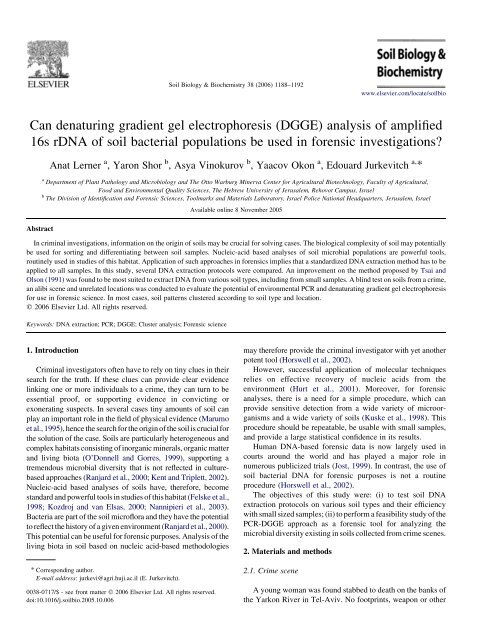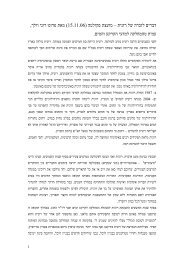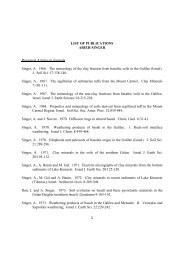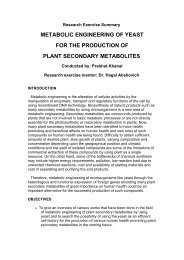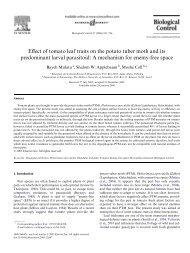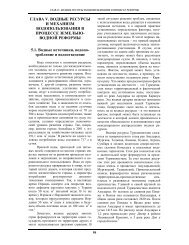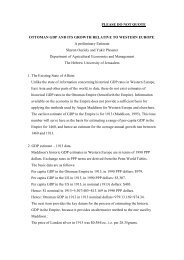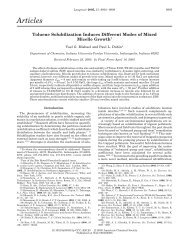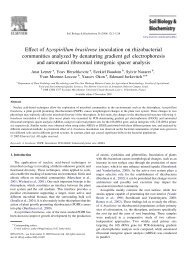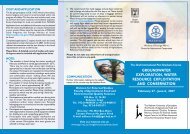Can denaturing gradient gel electrophoresis (DGGE) analysis of ...
Can denaturing gradient gel electrophoresis (DGGE) analysis of ...
Can denaturing gradient gel electrophoresis (DGGE) analysis of ...
You also want an ePaper? Increase the reach of your titles
YUMPU automatically turns print PDFs into web optimized ePapers that Google loves.
Soil Biology & Biochemistry 38 (2006) 1188–1192<br />
www.elsevier.com/locate/soilbio<br />
<strong>Can</strong> <strong>denaturing</strong> <strong>gradient</strong> <strong>gel</strong> <strong>electrophoresis</strong> (<strong>DGGE</strong>) <strong>analysis</strong> <strong>of</strong> amplified<br />
16s rDNA <strong>of</strong> soil bacterial populations be used in forensic investigations<br />
Anat Lerner a , Yaron Shor b , Asya Vinokurov b , Yaacov Okon a , Edouard Jurkevitch a, *<br />
a Department <strong>of</strong> Plant Pathology and Microbiology and The Otto Warburg Minerva Center for Agricultural Biotechnology, Faculty <strong>of</strong> Agricultural,<br />
Food and Environmental Quality Sciences, The Hebrew University <strong>of</strong> Jerusalem, Rehovot Campus, Israel<br />
b The Division <strong>of</strong> Identification and Forensic Sciences, Toolmarks and Materials Laboratory, Israel Police National Headquarters, Jerusalem, Israel<br />
Available online 8 November 2005<br />
Abstract<br />
In criminal investigations, information on the origin <strong>of</strong> soils may be crucial for solving cases. The biological complexity <strong>of</strong> soil may potentially<br />
be used for sorting and differentiating between soil samples. Nucleic-acid based analyses <strong>of</strong> soil microbial populations are powerful tools,<br />
routinely used in studies <strong>of</strong> this habitat. Application <strong>of</strong> such approaches in forensics implies that a standardized DNA extraction method has to be<br />
applied to all samples. In this study, several DNA extraction protocols were compared. An improvement on the method proposed by Tsai and<br />
Olson (1991) was found to be most suited to extract DNA from various soil types, including from small samples. A blind test on soils from a crime,<br />
an alibi scene and unrelated locations was conducted to evaluate the potential <strong>of</strong> environmental PCR and denaturating <strong>gradient</strong> <strong>gel</strong> <strong>electrophoresis</strong><br />
for use in forensic science. In most cases, soil patterns clustered according to soil type and location.<br />
q 2006 Elsevier Ltd. All rights reserved.<br />
Keywords: DNA extraction; PCR; <strong>DGGE</strong>; Cluster <strong>analysis</strong>; Forensic science<br />
1. Introduction<br />
Criminal investigators <strong>of</strong>ten have to rely on tiny clues in their<br />
search for the truth. If these clues can provide clear evidence<br />
linking one or more individuals to a crime, they can turn to be<br />
essential pro<strong>of</strong>, or supporting evidence in convicting or<br />
exonerating suspects. In several cases tiny amounts <strong>of</strong> soil can<br />
play an important role in the field <strong>of</strong> physical evidence (Marumo<br />
et al., 1995), hence the search for the origin <strong>of</strong> the soil is crucial for<br />
the solution <strong>of</strong> the case. Soils are particularly heterogeneous and<br />
complex habitats consisting <strong>of</strong> inorganic minerals, organic matter<br />
and living biota (O’Donnell and Gorres, 1999), supporting a<br />
tremendous microbial diversity that is not reflected in culturebased<br />
approaches (Ranjard et al., 2000; Kent and Triplett, 2002).<br />
Nucleic-acid based analyses <strong>of</strong> soils have, therefore, become<br />
standard and powerful tools in studies <strong>of</strong> this habitat (Felske et al.,<br />
1998; Kozdroj and van Elsas, 2000; Nannipieri et al., 2003).<br />
Bacteria are part <strong>of</strong> the soil micr<strong>of</strong>lora and they have the potential<br />
to reflect the history <strong>of</strong> a given environment (Ranjard et al., 2000).<br />
This potential can be useful for forensic purposes. Analysis <strong>of</strong> the<br />
living biota in soil based on nucleic acid-based methodologies<br />
* Corresponding author.<br />
E-mail address: jurkevi@agri.huji.ac.il (E. Jurkevitch).<br />
0038-0717/$ - see front matter q 2006 Elsevier Ltd. All rights reserved.<br />
doi:10.1016/j.soilbio.2005.10.006<br />
may therefore provide the criminal investigator with yet another<br />
potent tool (Horswell et al., 2002).<br />
However, successful application <strong>of</strong> molecular techniques<br />
relies on effective recovery <strong>of</strong> nucleic acids from the<br />
environment (Hurt et al., 2001). Moreover, for forensic<br />
analyses, there is a need for a simple procedure, which can<br />
provide sensitive detection from a wide variety <strong>of</strong> microorganisms<br />
and a wide variety <strong>of</strong> soils (Kuske et al., 1998). This<br />
procedure should be repeatable, be usable with small samples,<br />
and provide a large statistical confidence in its results.<br />
Human DNA-based forensic data is now lar<strong>gel</strong>y used in<br />
courts around the world and has played a major role in<br />
numerous publicized trials (Jost, 1999). In contrast, the use <strong>of</strong><br />
soil bacterial DNA for forensic purposes is not a routine<br />
procedure (Horswell et al., 2002).<br />
The objectives <strong>of</strong> this study were: (i) to test soil DNA<br />
extraction protocols on various soil types and their efficiency<br />
with small sized samples; (ii) to perform a feasibility study <strong>of</strong> the<br />
PCR-<strong>DGGE</strong> approach as a forensic tool for analyzing the<br />
microbial diversity existing in soils collected from crime scenes.<br />
2. Materials and methods<br />
2.1. Crime scene<br />
A young woman was found stabbed to death on the banks <strong>of</strong><br />
the Yarkon River in Tel-Aviv. No footprints, weapon or other
A. Lerner et al. / Soil Biology & Biochemistry 38 (2006) 1188–1192 1189<br />
physical evidence was found in the crime scene. The main<br />
suspect, arrested a couple <strong>of</strong> days later, claimed to have been<br />
with the victim on a non-asphalted, nearby parking lot (the alibi<br />
area). The suspect washed his clothes and shoes after the<br />
murder and the only possible link to the crime scene was a<br />
small soil clot (0.2 g) found inside his shoe.<br />
2.2. Soils<br />
Soils samples were collected from different locations<br />
(Table 1). Soils used for the evaluation <strong>of</strong> DNA extraction<br />
protocols were sampled 5 cm below the surface, and kept on<br />
ice until processed. Samples originating from the crime scene<br />
were kept in plastic bags on the shelf and in the dark for<br />
6 months until <strong>analysis</strong>. The soil clot from the suspect’s shoe<br />
was not made available for <strong>analysis</strong> by the court because <strong>of</strong> the<br />
destructive nature <strong>of</strong> the <strong>analysis</strong>.<br />
2.3. Soil wash<br />
Soil samples in 1.8 ml <strong>of</strong> 0.05 M buffer phosphate and 0.5%<br />
cetyltrimethylammonium bromide (CTAB) were ground using<br />
a mortar and pestle. Samples were shaken for 3 h at 4 8C and<br />
200 rev min K1 , and then centrifuged for 10 min at 4 8C and<br />
700 rev min K1 . The supernatant was removed and DNA<br />
extraction was performed.<br />
2.4. DNA extraction<br />
Five direct methods were used for DNA extraction from<br />
bacterial communities: (a) Tsai and Olson (1991) (thereafter<br />
‘T’) with slight modifications: After three freeze-thaw cycles,<br />
proteinase K was added to the solution to a final concentration<br />
<strong>of</strong> 50 mg ml K1 and the samples were incubated for 30 min at<br />
37 8C; (b) Zhou et al. (1996) (‘Z’); (c) Yeates et al. (1998)<br />
(‘Y’); (d-e) methods based on the commercial kits FastDNA<br />
SPIN Kit for Soil (BIO 101, Qbiogene, Inc, Carlsbad, USA)<br />
(‘F’) and UltraCleane Soil DNA kit (MO BIO Laboratories,<br />
USA) (‘U’). The Y and F methods included a bead beating step.<br />
Samples weighing 0.2, 1, 10, 0.6, and 0.25 g were used with<br />
methods, T and Y, Z, F, and U, respectively. The weight <strong>of</strong> the<br />
soil samples was the optimum recommended for each protocol.<br />
2.5. Purification <strong>of</strong> crude DNA extracts<br />
The QIAquick Gel Extraction kit (QIAGEN GmbH, Hilden,<br />
Germany, and DNA Isolation kit (Biological Ind., Israel) were<br />
used to purify DNA.<br />
2.6. PCR amplification<br />
One to three microlitre <strong>of</strong> each DNA preparation from<br />
environmental sample were amplified in a PCR reaction<br />
mixture (50 ml) using an Eppendorf Mastercycler Gradient<br />
(Brinkmann Instruments, Inc., USA). Each PCR mixture<br />
contained 0.8 mM <strong>of</strong> each primer, 0.3 mM <strong>of</strong> each deoxynucleotide<br />
(dNTP), 5 ml <strong>of</strong> 10! buffer (Promega, Madison,<br />
USA), 0.03 unit ml K1 redTaq DNA polymerase (Sigma,<br />
Rehovot, Israel), 3.75 mM MgCl 2 ,2ml <strong>of</strong>10mgml K1 BSA<br />
and double distilled, sterilized water to complete the mixture<br />
volume. The primers for PCR were specific for conserved<br />
bacterial 16S rDNA sequences (Heuer et al., 1997). PCR with<br />
primers Gm5f (5 0 -GC-clamp-CCT ACG GGA GGC AGC<br />
AG-3 0 ) and 907r (5 0 -CCC CGT CAA TTC CTT TGA GTT<br />
T-3) amplified a bacterial 16S rDNA fragment from position<br />
341–928 (Escherichia coli numbering). PCR amplification was<br />
performed for 35 cycles as follows: after initial denaturation <strong>of</strong><br />
1 min at 95 8C each cycle consisted <strong>of</strong> denaturation at 95 8C for<br />
20 s, primer annealing at 57 8C for 25 s, and primer extension<br />
at 72 8C from 30 s. Cycling was followed by final primer<br />
extension at 72 8C from 1 min. PCR products were visualized<br />
by <strong>electrophoresis</strong> in 1% (w/v) agarose <strong>gel</strong>s after 1 mg ml K1<br />
EtBr staining (Sambrook et al., 1989).<br />
2.7. Denaturing <strong>gradient</strong> <strong>gel</strong> <strong>electrophoresis</strong><br />
Strong PCR products <strong>of</strong> the expected size (550 bp) were<br />
subjected to <strong>DGGE</strong> <strong>analysis</strong>. <strong>DGGE</strong> was performed with an<br />
Ingeny phor U-2 system (Leiden, The Netherlands). Samples <strong>of</strong><br />
43 ml <strong>of</strong> PCR product were loaded onto 6% (w/v) polyacrylamide<br />
<strong>gel</strong>s in 1.0 strength Tris-ethylene-diamineteraacetate<br />
Table 1<br />
Properties <strong>of</strong> the soils used in this study<br />
Location Texture Sampling zone Organic matter (%) pH Moisture content (%)<br />
Kfar Menachem,<br />
Sandy loam (Chromoxererts brown alluvial) Maize rhizosphere 0.9 7.23 5.5–6<br />
Israel<br />
Rehovot, Sandy (Haploxeralfs brown–red) Maize rhizosphere 0.5 8.4 27.9<br />
Israel<br />
Hula, Israel Peat (Lacustrine gley) Surface soil 29.3 7.26 84.5<br />
Coconut Compost (15% polystyrene) 85 4.8–5.6 30–35<br />
residues<br />
medium<br />
Crime scene Sandy clay loam (Hamric alluvial soils and gley) Surface soil N.D. N.D. N.D.<br />
Alibi scene Sandy clay loam (Calcareous sandstone) Surface soil N.D. N.D. N.D.<br />
Suspect’s<br />
home<br />
Sandy loam Surface soil N.D. N.D. N.D.<br />
N.D.: not determined.
1190<br />
A. Lerner et al. / Soil Biology & Biochemistry 38 (2006) 1188–1192<br />
(TAE, pH 8.5) TAE buffer. The polyacrylamide <strong>gel</strong>s were<br />
prepared with a <strong>denaturing</strong> <strong>gradient</strong> ranging from 30 to 60%<br />
(where 80% denaturant contained 7 M urea and 40%<br />
formamide). The <strong>electrophoresis</strong> was run for 20 h at 85 V<br />
at 60 8C. After the runs, <strong>gel</strong>s were removed from the set up and<br />
stained for 30 min with 2 l <strong>of</strong> 1!TAE and 100 ml <strong>of</strong><br />
10 mg ml K1 EtBr solution followed by washing with 1!<br />
TAE for 15 min. The stained <strong>gel</strong>s were immediately<br />
photographed using an AlphaImagere System (Labtrade<br />
Inc., FL, USA).<br />
2.8. Cluster <strong>analysis</strong><br />
The <strong>analysis</strong> was performed as blind test in which the<br />
operator was unaware <strong>of</strong> the origin <strong>of</strong> the samples. Cluster<br />
<strong>analysis</strong> <strong>of</strong> pr<strong>of</strong>ile similarity was performed using the<br />
Discovery Series Quantity One 1-D Analysis S<strong>of</strong>tware Version<br />
4.4.1, PC (Bio-Rad, Rishon Le Zion, Israel) and UPGMA.<br />
3. Results<br />
3.1. DNA extraction<br />
All the protocols used in this study were based on direct<br />
DNA extraction. Direct DNA protocols include three main<br />
elements: chemical, physical and enzymatic lysis (Miller et al.,<br />
1999). Each protocol, which had been tested herein, included<br />
one or more <strong>of</strong> these elements. Of the methods tested, only<br />
protocols T, F and Z were successful in extracting DNA from a<br />
Rehovot and a Kfar Menachem maize rhizosphere soil.<br />
DNA was also successfully extracted from a coconut<br />
residues medium and from Hula soil, two highly organic<br />
soils, using the T and F methods (Table 1). The use <strong>of</strong> the DNA<br />
Isolation kit (Biological Ind., Israel), failed to remove humic<br />
acids and resulted in brownish samples that could not be<br />
amplified by PCR using primers for the 16S rRNA gene. After<br />
a second purification step, including electrophoretic separation<br />
<strong>of</strong> humic substances from DNA in agarose, DNA excision from<br />
the <strong>gel</strong> and purification using QIAquick Gel Extraction kit<br />
(QIAGEN GmbH, Hilden, Germany), PCR products were<br />
obtained.<br />
As a lesser amount <strong>of</strong> impurities co-extracted with DNA,<br />
protocol T was selected as the DNA extraction method to be<br />
used for the evaluation <strong>of</strong> soil microbial community <strong>analysis</strong><br />
for forensic purposes.<br />
3.2. Microbial community <strong>analysis</strong><br />
Soil samples were taken at various places at and around<br />
the murder scene, at the alibi area and near the family<br />
parking lot at the main suspect’s home. In some forensic<br />
cases, the amount <strong>of</strong> material collected is so low that no<br />
replicate samples can be obtained (for example, soil<br />
adhering to a sole, or to a piece <strong>of</strong> cloth). In order to<br />
reflect this situation, the presented <strong>analysis</strong> was performed:<br />
(i) without prior knowledge <strong>of</strong> the origin <strong>of</strong> the samples,<br />
and; (ii) with only one replicate per location.<br />
Therefore, to mimic the amount found on the suspect’s shoe<br />
(around 0.2 g), which was not available, and to evaluate the<br />
efficiency <strong>of</strong> the protocol T, 0.2–0.6 g <strong>of</strong> soil was extracted. DNA<br />
was retrieved from all samples. In some instances, amplicons<br />
were only obtained after dilution <strong>of</strong> the DNA samples.<br />
<strong>DGGE</strong> was performed on the samples originating from the<br />
crime scene, from the alibi scene, from the suspect’s home and<br />
from different geographical places in Israel in a blind test.<br />
Banding patterns were compared using cluster <strong>analysis</strong>. All<br />
samples collected from the crime scene and surroundings<br />
clustered together. All the samples from the alibi scene and<br />
surroundings were clearly separated from the crime scene<br />
samples. They clustered closer to the samples from Rehovot<br />
and Kfar Menahem, two soils with a texture similar to that <strong>of</strong><br />
the alibi scene samples. Also, a Beit Dagan and a Hula soil,<br />
both richer in organic matter appeared to be closer to the crime<br />
scene samples. However, a sample from the suspect’s home<br />
also clustered with crime scene samples (Fig. 1).<br />
4. Discussion<br />
4.1. Use <strong>of</strong> soils in forensic science<br />
Molecular approaches have become a common tool for the<br />
<strong>analysis</strong> <strong>of</strong> the effect <strong>of</strong> plant cover, agricultural amendments,<br />
pollutants and environmental disorders on soil microbial<br />
communities (Torsvik et al., 1998; Marilley and Aragno,<br />
1999; Smit et al., 2001; Johnsen et al., 2001). Such tools may<br />
also prove useful in criminal investigations to link a suspect to<br />
a crime scene. The first requirement for implementing such<br />
methods is a reliable, convenient and reproducible method <strong>of</strong><br />
DNA extraction from soils.<br />
A number <strong>of</strong> methods for extracting DNA from diverse<br />
environments such as soils are available. Thus, the first step <strong>of</strong><br />
this study was to compare the efficacy <strong>of</strong> DNA retrieval with<br />
various methods on a particular soil type (Haploxeralfs brown–<br />
red <strong>of</strong> Rehovot). The amount <strong>of</strong> DNA extracted was evaluated<br />
by running the DNA obtained on <strong>gel</strong> agarose and comparing<br />
the band intensity after EtBr staining. Zhou et al. (1996) found<br />
a negative correlation between cell lysis efficiency and clay<br />
content, in contrast to Ranjard et al. (2000) who found no such<br />
significant correlation. Our results are in better agreement with<br />
those <strong>of</strong> Ranjard et al. (1998) as the ‘Z’ protocol (Zhou et al.,<br />
1996) applied to an Haploxeralfs brown–red soil with a low<br />
clay content only yielded low amounts <strong>of</strong> DNA. Bead beating,<br />
although recommended for sandy soils (Yeates et al., 1998),<br />
was found to be rather inefficient for this Haploxeralfs soil.<br />
Furthermore, only three out <strong>of</strong> the five methods evaluated<br />
successfully extracted DNA from a loamy sand test soil<br />
(Chromoxererts brown alluvial <strong>of</strong> Kfar Menachem). Further<br />
comparison with other soil types clearly showed that the timeconsuming<br />
Tsai and Olson (1991) protocol (protocol T) was<br />
the most suitable. The combination <strong>of</strong> physical, chemical and<br />
enzymatic attack <strong>of</strong> the cell wall in addition to initial grinding<br />
<strong>of</strong> the sample enabled efficient recovery <strong>of</strong> DNA from<br />
small samples (0.2 g) and from all soil types. Furthermore,<br />
DNA could also be extracted and amplified from pieces <strong>of</strong>
A. Lerner et al. / Soil Biology & Biochemistry 38 (2006) 1188–1192 1191<br />
(a)<br />
0.44 0.60 0.70 0.80<br />
1.00<br />
Beit Dagan<br />
(b)<br />
cloth containing traces <strong>of</strong> soil type (crime scene) and weighing<br />
0.2–1 g.<br />
Another advantage <strong>of</strong> protocol T approach was the<br />
relatively low amount <strong>of</strong> DNA shearing, which increased<br />
when bead beating was applied. Shearing may lead to<br />
amplification <strong>of</strong> chimeric products and to bands that do not<br />
reflect the actual diversity in a subsequent <strong>DGGE</strong> <strong>analysis</strong><br />
(Wintzingerode et al., 1997; Roose-Amsaleg et al., 2001). In<br />
addition, more humic substances were co-extracted with bead<br />
beating (protocol F) than with protocol T.<br />
4.2. Microbial community <strong>analysis</strong><br />
Hula valley<br />
Rehovot<br />
Crime scene<br />
Crime scene<br />
surrounding area<br />
Crime scene<br />
Suspect’s home<br />
Kfar Menachem<br />
Rhizosphere<br />
Rehovot Rhizosphere<br />
Alibi scene,10m west<br />
Alibi scene<br />
Alibi scene,10m east<br />
Alibi scene,10m south<br />
1 2 3 4 5 6 7 8 9 10 11 12 13<br />
Fig. 1. Cluster <strong>analysis</strong> (A) and <strong>DGGE</strong> pr<strong>of</strong>iles (B) <strong>of</strong> bacterial communities<br />
from different soils. Lanes: 1, crime scene; 2, Alibi scene; 3, Alibi scene, 10 m<br />
south; 4, Alibi scene, 10 m east; 5, suspect’s home; 6, crime scene surrounding<br />
area; 7, Alibi scene, 10 m west; 8, Hula valley; 9, Beit Dagan; 10, Rhizosphere<br />
Rehovot; 11, Rhizosphere Kfar Menahem; 12, Rehovot, and; 13, CRIME scene.<br />
Pr<strong>of</strong>iling <strong>of</strong> bacterial soil and rhizosphere communities by<br />
<strong>denaturing</strong> <strong>gradient</strong> <strong>gel</strong>s is a powerful tool for rapid <strong>analysis</strong> <strong>of</strong><br />
temporal and spatial variations in the soil and the rhizosphere.<br />
Although the samples from the suspect’s home and from the<br />
crime scene could not be separated based on cluster <strong>analysis</strong>,<br />
<strong>DGGE</strong> reflected a large bacterial diversity, which, in most<br />
cases clustered according to soil type and location. Plant roots<br />
are sources for organic matter, and directly influence the<br />
bacterial community associated with them, as reflected in<br />
changes in PCR-<strong>DGGE</strong> patterns between bulk and rhizosphere<br />
soil samples. In the test case described here, there was partial<br />
plant cover on soils at the crime scene and in the garden next to<br />
the suspect’s house, but not at the alibi scene. This might have<br />
influenced the bacterial composition, yielding more similar<br />
banding pr<strong>of</strong>iles.<br />
The simulation presented here called for the evaluation <strong>of</strong><br />
non-replicated samples, a situation which can seriously limit<br />
the sorting <strong>of</strong> samples <strong>of</strong> different origins. We suggest that by<br />
replicating the methods used for fingerprinting and the<br />
analytical approaches, statistical support could be achieved.<br />
In an accompanying paper (Lerner et al., 2006), we show that<br />
the pr<strong>of</strong>iling <strong>of</strong> rhizobacterial populations performed with<br />
<strong>DGGE</strong> and different primer sets and with ribosomal intergenic<br />
spacer <strong>analysis</strong>, and analyzed by different statistical methods<br />
yielded similar results.<br />
Sample collection can have an effect on subsequent analyses<br />
and proper handling, including tool disinfection, the use <strong>of</strong><br />
plastic bags to slow down gas exchange and appropriate and<br />
standardized storage conditions are recommended (Wintzingerode<br />
et al., 1997). PCR-<strong>DGGE</strong> is powerful fingerprint tool<br />
but it also has drawbacks: for example, bands can migrate to<br />
the same position, there is a strong bias for dominant<br />
populations, and multiple rrn copies from the same organism<br />
can yield different bands (Nannipieri et al., 2003). These biases<br />
appear in addition to those generated by differential DNA<br />
extraction and amplification (Roose-Amsaleg et al., 2001).<br />
4.3. Recommendations<br />
In conclusion, the following should be considered for an<br />
in-depth evaluation <strong>of</strong> the approach: whenever possible,<br />
samples should be collected as soon as the crime is discovered,<br />
as much material as possible should be retrieved from the<br />
locations under investigation, including soils with and without<br />
rhizosphere, from different depths and different positions at and<br />
near the crime scene, and in unrelated areas; Sample collection<br />
and storage should be standardized to minimize their impact on<br />
the bacterial community, and the <strong>analysis</strong> should be performed<br />
as rapidly as possible after sample collection (Wintzingerode<br />
et al., 1997); Samples should be analyzed using a number <strong>of</strong><br />
primer sets, including phylogenetically-restricted primers<br />
targeting specific populations. Statistical <strong>analysis</strong> should be<br />
performed using at least two different methods such as cluster<br />
and principal component <strong>analysis</strong>. Whenever needed, sequence<br />
information (from bands running identically in <strong>DGGE</strong> for<br />
example) should be sought to strengthen statistical power. We<br />
also suggest that a molecular survey <strong>of</strong> soils from different<br />
geographical and climatic regions should be undertaken using<br />
the guidelines stated above to obtain a large amount <strong>of</strong> data
1192<br />
A. Lerner et al. / Soil Biology & Biochemistry 38 (2006) 1188–1192<br />
which could be used to calculate the statistical strength <strong>of</strong> such<br />
analyses.<br />
References<br />
Felske, A., Wolterink, A., van Lis, R., Akkermans, A.D.L., 1998. Phylogeny <strong>of</strong><br />
the main bacterial 16S rRNA sequences in Drentse a grassland soils (The<br />
Netherlands). Applied and Environmental Microbiology 64, 871–879.<br />
Heuer, H., Krsek, M., Baker, P., Smalla, K., Wellington, E.M.H., 1997.<br />
Analysis <strong>of</strong> actinomycete communities by specific amplification <strong>of</strong> genes<br />
encoding 16S rRNA and <strong>gel</strong>-<strong>electrophoresis</strong> separation in <strong>denaturing</strong><br />
<strong>gradient</strong>s. Applied and Environmental Microbiology 63, 3233–3241.<br />
Horswell, J., Cordiner, J.S., Maas, E.W., Martin, T.M., Sutherland, B.W.,<br />
Speir, T.W., Nogales, B., Osborn, A.M., 2002. Forensic comparison <strong>of</strong> soils<br />
by bacterial community DNA pr<strong>of</strong>iling. Journal <strong>of</strong> Forensic Science 47,<br />
350–353.<br />
Hurt, R.A., Qiu, X., Wu, L., Roh, Y., Palumbo, A.V., Tiedje, J.M., Zhou, J.,<br />
2001. Simultaneous recovery <strong>of</strong> RNA and DNA from soils and sediments.<br />
Applied and Environmental Microbiology 67, 4495–4503.<br />
Johnsen, K., Jacobsen, C.S., Torsvik, V., Sorensen, J., 2001. Pesticide effects<br />
on bacterial diversity in agricultural soils—a review. Biology and Fertility<br />
<strong>of</strong> Soils 33, 443–453.<br />
Jost, K., 1999. DNA databases. Does expanding them threaten civil liberties<br />
The CQ Researcher 9, 449–472.<br />
Kent, A.D., Triplett, E.W., 2002. Microbial communities and their interactions<br />
in soil and rhizosphere ecosystems. Annual Review in Microbiology 56,<br />
211–236.<br />
Kozdroj, J., van Elsas, J.D., 2000. Application <strong>of</strong> polymerase chain reaction<strong>denaturing</strong><br />
<strong>gradient</strong> <strong>gel</strong> <strong>electrophoresis</strong> for comparison <strong>of</strong> direct and<br />
indirect extraction methods <strong>of</strong> soil DNA used for microbial community<br />
fingerprinting. Biology and Fertility <strong>of</strong> Soils 31, 372–378.<br />
Kuske, C.R., Baton, K.L., Adorada, D.L., Stark, P.C., Hill, K.K., Jackson, P.J.,<br />
1998. Small-scale DNA sample preparation method for field PCR detection<br />
<strong>of</strong> microbial cells and spores in soil. Applied and Environmental<br />
Microbiology 64, 2463–2472.<br />
Lerner, A., Herschkovitz, Y., Baudoin, E., Nazaret, S., Moenne-Loccoz, Y.,<br />
Okon, Y., Jurkevitch, E., 2006. Effect <strong>of</strong> Azospirillum brasilense inoculation<br />
on rhizobacterial communities analyzed by <strong>denaturing</strong> <strong>gradient</strong> <strong>gel</strong><br />
<strong>electrophoresis</strong> and automated ribosomal intergenic spacer <strong>analysis</strong>. Soil<br />
Biology & Biochemistry 38, this issue, doi:10.1016/j.soilbio.2005.10.007.<br />
Marilley, L., Aragno, M., 1999. Phylogenetic diversity <strong>of</strong> bacterial<br />
communities differing in degree <strong>of</strong> proximity <strong>of</strong> Lolium perenne and<br />
Trifolium repens roots. Applied Soil Ecology 13, 127–136.<br />
Marumo, Y., Sugita, R., Seta, S., 1995. Soil as evidence in criminal<br />
investigation. The 11th Interpol Forensic Science Symposium, pp. 1–16.<br />
Miller, D.N., Bryant, J.E., Madsen, E.L., Ghiorse, W.C., 1999. Evaluation and<br />
optimization <strong>of</strong> DNA extraction and purification procedures for soil and<br />
sediments samples. Applied and Environmental Microbiology 65, 4715–<br />
4724.<br />
Nannipieri, P., Ascher, J., Ceccherini, M.T., Landi, L., Pietramellara, G.,<br />
Renella, G., 2003. Microbial diversity and soil functions. European Journal<br />
<strong>of</strong> Soil Science 54, 655–670.<br />
O’Donnell, A.G., Gorres, H.E., 1999. 16S rDNA methods in soil microbiology.<br />
Current Opinion in Biotechnology 10, 225–229.<br />
Ranjard, L., Poly, F., Nazaret, S., 2000. Monitoring complex bacterial<br />
communities using culture-independent molecular techniques: application<br />
to soil environment. Research in Microbiology 151, 167–177.<br />
Roose-Amsaleg, C.L., Garnier-Sillam, E., Harry, M., 2001. Extraction and<br />
purification <strong>of</strong> microbial DNA from soil and sediment samples. Applied<br />
Soil Ecology 18, 47–60.<br />
Sambrook, J., Fritsch, E.F., Maniatis, T., 1989. Molecular Cloning, A<br />
Laboratory Manual, second ed. Cold Spring Harbor Laboratory Press,<br />
Cold Spring Harbor, NY.<br />
Smit, E., Leefland, P., Gommans, S., van den Broek, J., van Mil, S., Wernars,<br />
K., 2001. Diversity and seasonal fluctuations <strong>of</strong> the dominant members <strong>of</strong><br />
the bacterial soil community in a wheat field as determined by cultivation<br />
and molecular methods. Applied and Environmental Microbiology 67,<br />
2284–2291.<br />
Torsvik, V., Daae, F.L., Sandaa, R.A., Ovreas, L., 1998. Novel techniques for<br />
analyzing microbial diversity in natural and perturbed environments.<br />
Journal <strong>of</strong> Biotechnology 64, 53–62.<br />
Tsai, Y.L., Olson, B.H., 1991. Rapid method for direct extraction <strong>of</strong> DNA from<br />
soil and sediments. Applied and Environmental Microbiology 57, 1070–<br />
1074.<br />
Wintzingerode, F.V., Gobel, U.B., Stackebrandt, E., 1997. Determination <strong>of</strong><br />
microbial diversity in environmental samples: pitfalls <strong>of</strong> PCR-based rRNA<br />
<strong>analysis</strong>. FEMS Microbiology Reviews 21, 213–229.<br />
Yeates, C., Gillings, M.R., Davidson, A.D., Altavilla, N., Veal, D.A., 1998.<br />
Methods for microbial DNA extraction from soil for PCR amplification.<br />
Biological Procedures Online 1, 40–47.<br />
Zhou, J., Bruns, M.A., Tiedje, J.M., 1996. DNA recovery from soils <strong>of</strong> diverse<br />
composition. Applied and Environmental Microbiology 62, 316–322.


